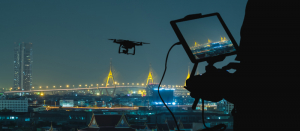Last week, on April 21st, the new Part 107 Flight Over People and Night Flight rules went into effect. What does that mean to you? With updated Part 107 training you’re now allowed to fly over people and at night with just a Part 107 license. Now that these rules are in place, old night and flight over people waivers that you might have had on your Part 107 will be terminated 60 days from the effective date. So, June 20th, 2021 is your deadline for training!
It isn’t just the wild-wild west where you’re allowed to fly over people at night in any fashion you see fit. There are new rules and regulations that the pilot and drone must meet before these flights can take place. We took the time, so you could spend your time on other things, to break down these rules and put them into a more digestible format.
Remote I.D & Part 107 Updates
- Course is FREE online
- Can be taken whenever to start flying with new rules (You DO NOT have to wait until your license expiry date)
- Can take this recurring test even if your license has expired
- No updated license for completion, but a certificate you need to keep on your person (Digital format is okay)
- The initial Part 107 test is still required to be taken at an approved FAA testing facility
Night Flight
- Flight at night is allowed, but must have anti-collision lights that can be seen for 3 statute miles and have a flash rate sufficient to avoid a collision. These anti-collision lights must be operational.
- Lights can be dimmed, but cannot be turned off
- Lights must have a strobing effect
- VO is no longer required, but definitely recommended
- To operate at night, pilots must complete either the updated initial test or the updated recurrent online training prior to conducting such operations
- Airspace Authorizations still apply and must be filed for the “night” timeframe of the flight
Flight Over People New rules
Category 1
- Less than .55lbs at takeoff. No exposed rotating parts
Category 2
- Drone not capable of causing more than 11 foot pounds of energy upon impact. No exposed rotating parts. No safety defects
- Requires FAA accepted Means of Compliance and FAA-accepted Declaration of Compliance
Category 3
- Drone not capable of causing more than 25 foot pounds of energy upon impact. No exposed rotating parts. No safety defects
- Requires FAA-accepted Means of Compliance and FAA-accepted Declaration of Compliance
- Only above people when:
- Closed or restricted access site and all persons have been given notice of the sUAS
- The sUAS does not maintain flight over people unless they are directly participating in flight, or under covered structure, or stationary vehicle
Category 4
- Must have an airworthiness certificate issued under Part 21
- Must be operated in accordance with the operating limitations specified in the approved Flight Manual or as otherwise specified by the FAA
Operations Over Moving Vehicles
Category 1,2, and 3
- No maintaining sustained flight over moving vehicles
- Transit operations only
- Aircraft must:
- Remain within or over a closed- or restricted-access site throughout the operation
- Ensure all persons located inside a moving vehicle within the closed- or restricted-access site are told that a small unmanned aircraft may fly over them.
- OR must not maintain sustained flight over moving vehicles.
Category 4
- Have an airworthiness certificate issued under part 21 of this chapter
- Be operated in accordance with the operating limitations specified in the approved Flight Manual or as otherwise specified by the FAA. The operating limitations must not prohibit operations over human beings located inside moving vehicles
To fly under these new rules, you will need to take the new Part 107 initial test or you need to take the recurrent course if you’re already a certified Part 107 pilot. To take this course go to FAASafety.gov and sign up for an account. You then simply sign up for the following course: ALC-677: Part 107 Small UAS Recurrent Non-Part 61 Pilots. The course should take you about 2 hours to complete and at the end you will have to answer 45 questions within 90 minutes. In case you do not pass, there is a 14 day waiting period. Then you can sign up and take it again! So take notes! And good luck!
Explore our Training Offerings:
